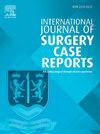Bilateral ovarian carcinosarcoma – A rare and aggressive malignancy: Case report
IF 0.6
Q4 SURGERY
引用次数: 0
Abstract
Introduction and importance
Carcinosarcoma of the ovary also referred to as malignant mixed Müllerian tumor (MMMT), is a rare and aggressive gynecological malignancy characterized by the presence of both epithelial and mesenchymal components. It accounts for <5 % of ovarian cancers, presenting significant diagnostic and therapeutic challenges due to its high-grade nature and poor prognosis.
Case presentation
We describe the case of a 75-year-old postmenopausal woman who presented with a three-month history of abdominal distension, pelvic pain, light vaginal bleeding, nausea, and early satiety. Imaging revealed a complex, multiloculated mass in the right adnexa with ascitic fluid. Elevated CA-125 levels supported the suspicion of malignancy. The patient underwent optimal surgery, including total abdominal hysterectomy, bilateral salpingo-oophorectomy, omentectomy, and appendectomy. Histopathological examination confirmed high-grade bilateral ovarian carcinosarcoma with a biphasic pattern of carcinomatous and sarcomatous components.
Clinical discussion
Ovarian carcinosarcoma is a rare and highly aggressive malignancy with a clinical presentation similar to other ovarian cancers. Imaging and tumor markers lack specificity, and definitive diagnosis relies on histopathology. Optimal surgery remains the cornerstone of management, followed by adjuvant chemotherapy. The prognosis is poor, with high recurrence rates and limited therapeutic options.
Conclusion
Ovarian carcinosarcoma represents a diagnostic and therapeutic challenge due to its aggressive nature and rarity. Early surgical intervention and multidisciplinary management are critical to improve patient outcomes. This case highlights the importance of heightened clinical awareness and histopathological confirmation in addressing this rare gynecological malignancy.
求助全文
约1分钟内获得全文
求助全文
来源期刊
CiteScore
1.10
自引率
0.00%
发文量
1116
审稿时长
46 days

 求助内容:
求助内容: 应助结果提醒方式:
应助结果提醒方式:


